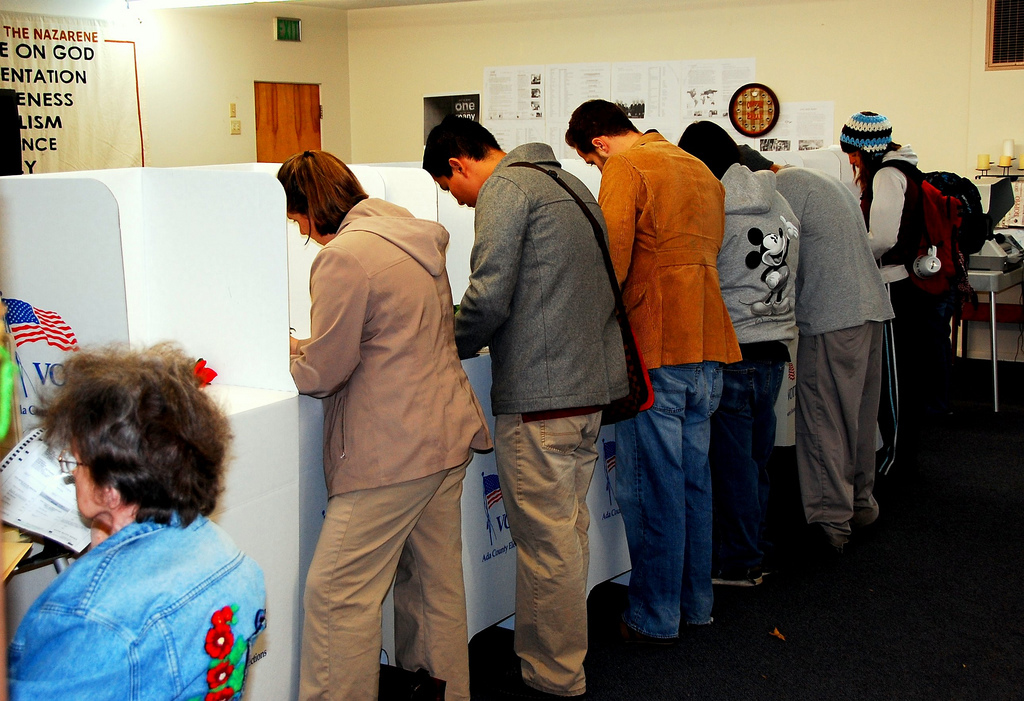
Tammy Patrick was a federal compliance officer for the Maricopa County Elections Department in Arizona for 11 years and served as a commissioner on President Obama’s bipartisan Presidential Commission on Election Administration. Today, in her role as a senior advisor to the Democracy Fund’s elections program, she speaks to journalists across the country about how they can improve their coverage of elections and help the public better understand the voting process.
In July 2018, Patrick spoke at Harvard’s Shorenstein Center on Media, Politics and Public Policy. Journalist’s Resource sat in on the talk. Here are eight of her best tips:
1. Get to know local election officials and follow them on social media.
Local election offices — and the people who run them – use social media to communicate with the public. Journalists can identify trends and potential problems based on what election officials share. Social media can be particularly helpful on Election Day, when election employees may post photos and videos of what they see and do throughout the day.
2. Remember that unofficial vote results are unofficial.
Election officials take time to process every ballot, including provisional and absentee ballots. A common myth that reporters can help correct is that officials count provisional or absentee ballots only in close races. Journalists can help the public better understand elections by running stories about officials processing ballots, checking voter signatures and taking other steps to ensure the integrity of the process.
3. Familiarize yourself with the election process before Election Day.
Some election offices hold press conferences specifically to answer reporters’ questions prior to Election Day, when officials will have limited time to assist reporters. Some offices also offer tours so journalists can photograph and get video of election employees doing behind-the-scenes work.
Take advantage of these opportunities. Use them to get to know the people who oversee elections and understand the intricacies of the election process, including strategies for dealing with problems such as security breaches.
4. Know the rules for accessing polling places.
Can journalists interview voters inside precinct buildings? Can they observe voters as they make their choices? Can they take photos of people casting ballots or waiting inside polling places? Know the rules before heading to the polls. Some states, for example, will allow cameras inside polling locations, but only when voters aren’t present.
5. Monitor these things on election days:
- Long wait times (Is the wait longer than 30 minutes? What’s the cause? Is the line moving?)
- Misinformation going out to or being shared among voters (Is someone advising voters they can vote by text message when they cannot?)
- Campaign-related complaints
- Voting machine issues (Are there enough machines? Are they not functioning correctly?)
- Registration system issues (Are voters having trouble checking in?)
- Voter help/hotlines
- Polling place issues (Are they opening on time? Are voters able to access the facilities, equipment and ballots?)
6. Remind voters ahead of time about key information.
People move often, so it’s important to remind them that election processes can differ by city, county and state. Journalists also should remind people who is eligible to vote and what they need to do or bring in order to vote. They should also explain voters’ options for casting ballots — for instance, submitting them by mail or during early voting events.
Many Americans don’t realize they must update their voter registrations after moving. Voter registration deadlines vary. As of July 2018, 15 states and the District of Columbia offer Election Day registration.
News organizations also should remind voters what election-related services are available in their areas — assistance for disabled voters and those who have difficulty communicating in English, for example.
7. Attend conferences and election trainings to stay up-to-date.
In each state, election officials gather regularly for conferences, which are a great way for journalists to meet election administrators and learn about changes related to election policy, technology and vote security. Attending trainings for poll workers, board workers and judges also can help journalists stay up-to-date on election issues. These events also are great opportunities to get on-the-record interviews, photographs and video footage.
8. These organizations offer resources for journalists writing about elections:
- U.S. Election Assistance Commission
- National Association of State Election Directors
- National Association of Secretaries of State
- U.S. Vote Foundation
- National Conference of State Legislators
- ElectionLine
Editor’s Note: Patrick co-hosted a free webinar for journalists through The Poynter Institute on June 28, 2018. The webinar, “Democracy on Deadline: Take Your Coverage of U.S. Elections to the Next Level,” runs about an hour.
Looking for election-related research? Check out Journalist’s Resource’s write-ups on how primary voters differ from general election voters, the role of race in voter turnout and how negative political ads affect voters.
Reporting on data security and privacy: Tips from Dipayan Ghosh
How to tell good research from bad: 13 questions journalists should ask
This photo, taken by Big Dubya and obtained from Flickr, is being used under a Creative Commons license. No changes were made.
